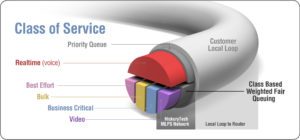QoS Solution

Quality of Service (QoS) provides you with the capability to control, how the different types of traffics in a network, are moved. The goal of QoS is to provide each traffic type with a virtual pipe. In order to achieve that, QoS uses traffic class mapping, scheduling, and flow control.
With all the traffic that is going through inbound and outbound ports, QoS can be set based on egress port and priority level. It can also be set on interfaces where the end-station knows how to mark traffic with QoS. In the practice, QoS are used to prioritize traffic for latency critical applications (such as voice or video) and to control the impact of more latency traffic.
Data Center Bridging (DCB) is a standart that enable converged fabrics in the data center, where storage, data networking, cluster inter-process communication, and management traffic all share the same Ethernet network infrastructure. DCB provides hardware-based bandwidth allocation to a specific type of traffic and enhances Ethernet transport reliability with the use of priority-based flow control. The main advantages is that enables server administrators and network administrators to assign an application to a particular traffic class or priority based on well-known protocols, well-known TCP/UDP port, or NetworkDirect port used by that application.
The solution that I select for implementing QoS in the case study is the application LANZ of Arista. That application work in a IP/Ethernet network and have the next advantages:
- Identifies buffer confestions before drops occur
- Provides proactive congestion management and notification
- Enables real-time queue depth analysis and streaming
- Tracks latency, microbursts and packet loss
In order to implement that I will opt for Arista 7150S switch because they are the best in ultra-low latency environments and offer that feature.
The main difference beetween Cisco and Arista is that Cisco implement QoS with FCoE while Arista does with LANZ, because they dont believe on FCoE and prefer a IP/Ethernet based solution.
